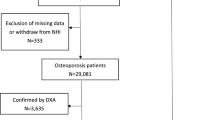Abstract
Background
The causes of rotator cuff tendon rupture are multifactorial and still unclear. Intrinsic and extrinsic factors have been implicated as predisposing risk factors for rotator cuff rupture. Previous studies have suggested a relationship between elevated serum lipid profiles and tendon ruptures, although not rotator cuff tears specifically.
Questions/purposes
We therefore asked whether patients with rotator cuff tears were more likely to have higher levels of hypercholesterolemia than patients with shoulder pain but without tears.
Methods
We prospectively collected serum cholesterol and lipid profiles on two age-matched populations of patients; 74 (mean age, 66.3 years) had ruptures of their rotator cuff tendons, whereas a control group of 73 patients (mean age, 67.4 years) were seen for nontendon-related shoulder complaints.
Results
Total cholesterol, triglycerides, and low-density lipoprotein cholesterol concentrations of the patients with rotator cuff tendon tears were higher, and their high-density lipoprotein cholesterol showed a trend to being lower than the control group. Forty-seven of 74 patients (63%) with rotator cuff tears had an elevated serum cholesterol (total cholesterol greater than 240 mg/dL) as compared with an overall rate of 28% in our control group.
Conclusions
Patients with rotator cuff tears were more likely to have hypercholesterolemia when compared with the control group.
Clinical relevance
Measurement of serum cholesterol in patients presenting with torn rotator cuff tendons should be considered in patients whose cholesterol profiles are unknown. Future consideration of drug treatment may reduce risk for future tendon degeneration, as well as improve quality of life and reduce mortality.
Level of Evidence
Level II, prognostic study. See Guidelines for Authors for a complete description of levels of evidence.

Similar content being viewed by others
References
Appel LJ, Sacks FM, Carey VJ, Obarzanek E, Swain JF, Miller ER III, Conlin PR, Erlinger TP, Rosner BA, Laranjo NM, Charleston J, McCarron P, Bishop LM. Effects of protein, monounsaturated fat, and carbohydrate intake on blood pressure and serum lipids: results of the OmniHeart randomized trial. JAMA. 2005;294:2455–2464.
Bigliani LU, Ticker JB, Flatow EL, Soslowsky LJ, Mow VC. The relationship of acromial architecture to rotator cuff disease. Clin Sports Med. 1991;10:823–838.
Brewer BJ. Aging of the rotator cuff. Am J Sports Med. 1979;7:102–110.
Crouse JR, Grundy SM, Ahrens EH Jr. Cholesterol distribution in the bulk tissues of man: variation with age. J Clin Invest. 1972;51:1292–1296.
Grundy SM, Cleeman JI, Merz CN, Brewer HB Jr, Clark LT, Hunninghake DB, Pasternak RC, Smith SC Jr, Stone NJ. Implications of recent clinical trials for the National Cholesterol Education Program Adult Treatment Panel III guidelines. Circulation. 2004;110:227–239.
Iannotti JP Naranja RJ, Gartsman GM. Surgical treatment of the intact cuff and repairable cuff defect: arthroscopic and open techniques. In: Norris TR, ed. Orthopaedic Knowledge Update: Shoulder and Elbow. Rosemont, IL: American Academy of Orthopaedic Surgeons; 1994:151–156.
Klemp P, Halland AM, Majoos FL, Steyn K. Musculoskeletal manifestations in hyperlipidaemia: a controlled study. Ann Rheum Dis. 1993;52:44–48.
Mathiak G, Wening JV, Mathiak M, Neville LF, Jungbluth K. Serum cholesterol is elevated in patients with Achilles tendon ruptures. Arch Orthop Trauma Surg. 1999;119:280–284.
Murano S, Shinomiya M, Shirai K, Saito Y, Yoshida S. Characteristic features of long-living patients with familial hypercholesterolemia in Japan. J Am Geriatr Soc. 1993;41:253–257.
Nho SJ, Yadav H, Shindle MK, Macgillivray JD. Rotator cuff degeneration: etiology and pathogenesis. Am J Sports Med. 2008;36:987–993.
Ozgurtas T, Yildiz C, Serdar M, Atesalp S, Kutluay T. Is high concentration of serum lipids a risk factor for Achilles tendon rupture? Clin Chim Acta. 2003;331:25–28.
Ronnemaa T, Juva K, Kulonen E. Effect of hyperlipidemic rat serum on the synthesis of collagen by chick embryo fibroblasts. Atherosclerosis. 1975;21:315–324.
Rothman RH, Parke WW. The vascular anatomy of the rotator cuff. Clin Orthop Relat Res. 1965;41:176–186.
Schober SE, Carroll MD, Lacher DA, Hirsch R. High serum total cholesterol–an indicator for monitoring cholesterol lowering efforts: U.S. adults, 2005–2006. NCHS Data Brief. Hyattsville, MD: Centers for Disease Control and Prevention, National Center for Health Statistics; 2007:1–8.
Tall AR, Small DM, Lees RS. Interaction of collagen with the lipids of tendon xanthomata. J Clin Invest. 1978;62:836–846.
Tempelhof S, Rupp S, Seil R. Age-related prevalence of rotator cuff tears in asymptomatic shoulders. J Shoulder Elbow Surg. 1999;8:296–299.
von Bahr S, Movin T, Papadogiannakis N, Pikuleva I, Ronnow P, Diczfalusy U, Bjorkhem I. Mechanism of accumulation of cholesterol and cholestanol in tendons and the role of sterol 27-hydroxylase (CYP27A1). Arterioscler Thromb Vasc Biol. 2002;22:1129–1135.
Yamaguchi K, Ditsios K, Middleton WD, Hildebolt CF, Galatz LM, Teefey SA. The demographic and morphological features of rotator cuff disease. A comparison of asymptomatic and symptomatic shoulders. J Bone Joint Surg Am. 2006;88:1699–1704.
Zehntner MK, Reitamo T, Mordasini R, Ledermann M. Traumatic rupture of the Achilles tendon and hyperlipidemia [in German]. Unfallheilkunde. 1984;87:226–229.
Acknowledgments
We thank William J. Warrender for his help with manuscript editing.
Author information
Authors and Affiliations
Corresponding author
Additional information
Each author certifies that he or she has no commercial associations (eg, consultancies, stock ownership, equity interest, patent/licensing arrangements, etc) that might pose a conflict of interest in connection with the submitted article.
Each author certifies that his or her institution approved the human protocol for this investigation, that all investigations were conducted in conformity with ethical principles of research, and that informed consent for participation in the study was obtained.
About this article
Cite this article
Abboud, J.A., Kim, J.S. The Effect of Hypercholesterolemia on Rotator Cuff Disease. Clin Orthop Relat Res 468, 1493–1497 (2010). https://doi.org/10.1007/s11999-009-1151-9
Published:
Issue Date:
DOI: https://doi.org/10.1007/s11999-009-1151-9




